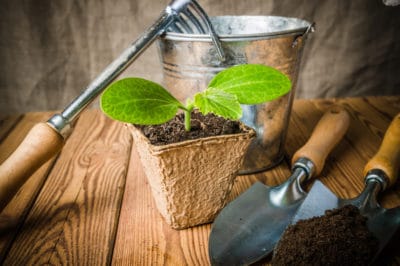Starting Indoors
If you’re planning a large vegetable garden, you can get started well before the last frost by planting seeds indoors and growing them up to transplant into the garden. Zucchini seeds should be started 4-6 weeks before the last frost.
You’ll need:
- Zucchini seeds in your chosen variety
- Seed starting mix
- Planting trays with covers
- Sunny location or plant light
- Warming Mat
Be sure to use a planting tray with a large cell size. Unlike plants like tomatoes and peppers, which can benefit from being transplanted into larger containers several times before they ever reach the garden, zucchini seedlings are fragile and don’t take well to transplanting.
Wet your seed starting mix thoroughly, and plant one seed per cell. Cover your growing trays and situate them in a bright, warm location. Keep the soil moist but not sodden; it shouldn’t ooze water if pressed. Once the seeds begin to break through the soil, remove the cover to prevent mold.
Choosing Seedlings at a Garden Center
Though you may not find as many varieties of zucchini available as seedlings rather than seeds, many garden centers will have some on hand. If you’re getting a late start, don’t have space to start your own seedlings, or need to replace plants killed off by pests or weather, picking up a pack of seedlings at a garden center is a great option.
Look for the smallest seedlings you can find. These tend to have the least developed root systems and can handle transplanting the best. Seed-starting medium is also low in nutrients, so heavy feeders like zucchini tend to get spindly and malnourished the older the seedlings get. Look for the darkest green leaves you can find.
Transplanting
When you’re ready to transplant, the first step is “hardening off,” or acclimating your plants to outdoor weather. After any risk of frost, leave them outdoors in a sunny, sheltered space. Leave them out for short periods at first, an hour or two at a time, then gradually extending this and moving your plants closer to their final location in your garden.
Gently remove your seedlings from their containers. If they don’t slide free, cut away the plastic to avoid disturbing the fragile roots. Place them into pre-dug holes at least three feet (0.9 meters) apart—farther if your variety grows large—and press soil firmly in place. Water well at soil level; this prevents the onset of fungal diseases like powdery mildew.
